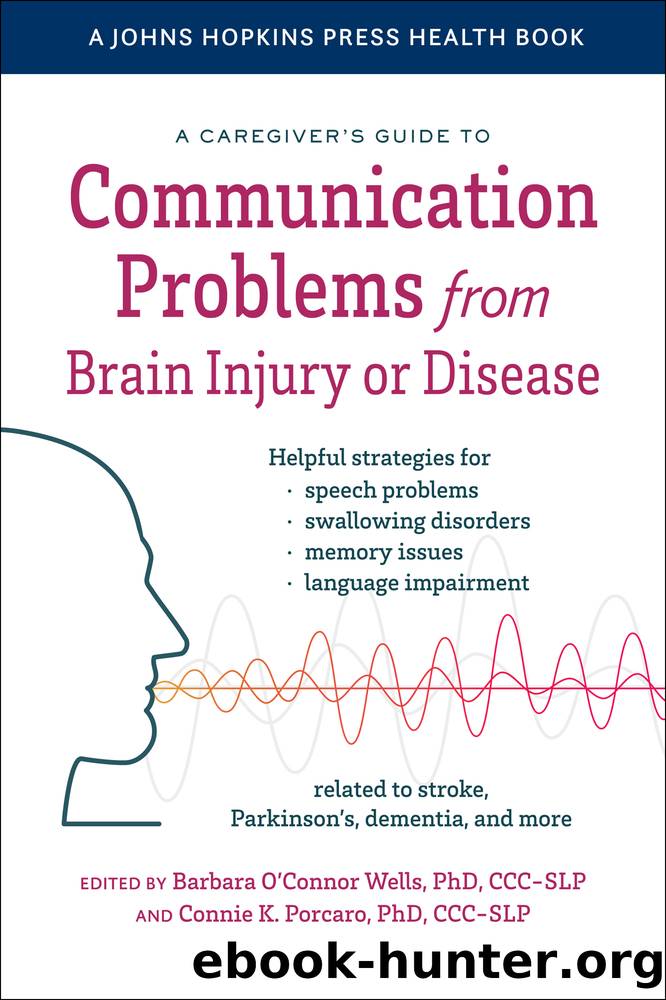A Caregiver's Guide to Communication Problems from Brain Injury or Disease by Barbara O'Connor Wells

Author:Barbara O'Connor Wells
Language: eng
Format: epub
Publisher: Johns Hopkins University Press
Published: 2021-10-15T00:00:00+00:00
What Are the Areas of the Brain Responsible for Language?
To understand how language works, it is important to understand what areas of the brain are critical for language. Language is stored in and controlled by the left side of the brain in about 85% of people, whether they are right or left handed (Brookshire & McNeil, 2015). For the other 15%, language is either stored in and controlled by the right side of the brain or both sides of the brain (depending on the languages spoken).
When describing the parts of the brain, we talk about the left and right halves of the brain, called hemispheres. Within each half (hemisphere), there are four lobes. Each half has a frontal lobe (in the front), a temporal lobe (in the area above the ear/temple), a parietal lobe (above and behind the temporal lobe), and an occipital lobe (at the back). For the purposes of this chapter, I am highlighting the major areas of the brain where language is primarily located. The brain is a complex organ, however, and language uses many of its areas. I focus here on the two main lobes of the brain for language: the frontal and temporal lobes. (See a helpful illustration of the brain in appendix D.)
Located in the âfrontâ part of the brain are the frontal lobes (one on the left and one on the right). The frontal lobe on the left side of the brain is important for controlling motor movements, like walking and talking. A particular part of this lobe, called Brocaâs area, is important for speaking. The frontal lobe also controls other key functions, like our attention span and personality.
The areas of the brain above our ears are called the temporal lobes. The temporal lobe in the language-dominant hemisphere (usually the left side) is important for hearing and understanding sounds. This lobe is directly behind the frontal lobe. Damage to a specific area in this lobe, called Wernickeâs area, will lead to problems in understanding speech. The arcuate fasciculus is a band of nerve fibers that runs between Brocaâs and Wernickeâs areas. This helps these two lobes of the brain communicate with each other.
Letâs use a simple example to show how this works. Imagine that someone asks you a question (for example, âWhatâs your name?â). Wernickeâs area helps to first understand the question. To respond to the question (that is, speak), the message needs to travel to the frontal lobe of the brain. In a healthy individual, once Brocaâs area receives the message, the person will be able to say their response (âMy name is Johnâ).
The frontal and temporal lobes of the brain both receive blood flow from the middle cerebral artery in the brain. If there is an interruption in this blood flow, then the result will be a language and communication impairment, which we call aphasia.
Download
This site does not store any files on its server. We only index and link to content provided by other sites. Please contact the content providers to delete copyright contents if any and email us, we'll remove relevant links or contents immediately.
Application of a Novel Technique for Clinical Evaluation of Nitric Oxide-Induced Free Radical Reactions in ICU Patients by Unknown(698)
Rosenâs Emergency Medicine Concepts and Clinical Practice by Ron Walls; Robert Hockberger; Marianne Gausche-Hill; Timothy B. Erickson; Susan R. Wilcox(574)
Oxidative damage to surfactant protein D in pulmonary diseases by Vitality Starosta1 & Matthias Griese1†(412)
Social Science Perspectives on Global Public Health by Vincent La Placa & Julia Morgan(375)
Constructing Canine Consent; Conceptualising and Adopting a Consent-focused Relationship with Dogs by ERIN JONES(331)
Organic Chemistry: An Acid - Base Approach by MICHAEL SMITH(305)
ADVANCED EMERGENCY CARE AND TRANSPORTATION OF THE SICK AND INJURED by Unknown(273)
Saunders Nursing Drug Handbook 2024 - E-Book by Unknown(267)
Davis's Comprehensive Manual of Laboratory and Diagnostic Tests with Nursing Implications by Unknown(250)
Socio-Life Science and the COVID-19 Outbreak : Public Health and Public Policy by Makoto Yano; Fumihiko Matsuda; Anavaj Sakuntabhai; Shigeru Hirota(249)
Diagnostic and Statistical Manual of Mental Disorders, Fifth Edition, Text Revision (DSM-5-TR(tm)) by Unknown(247)
Human Microanatomy; Cell Tissue and Organ Histology with Celebrity Medical Histories by Stephen A. Stricker(246)
Berne and Levy Physiology E-Book by Unknown(237)
Replacing the Dead by Mie Nakachi;(234)
Handbook of Skin Disease Management by Jiyad Zainab;Flohr Carsten; & Carsten Flohr(232)
Access to Medicines and Vaccines in the South : Coherence of Rules and Policies Applied by the European Union Commission by Stephen Kingah(231)
Deep Learning and Medical Applications by Unknown(224)
The Pocket Guide to Sensorimotor Psychotherapy in Context (Norton Series on Interpersonal Neurobiology) by Pat Ogden(222)
Advances and Technical Standards in Neurosurgery by Unknown(216)
